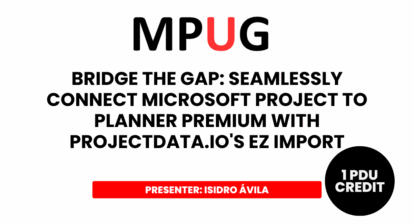 Over the years many folks in client sites have noticed the glowing apple on the lid of my laptop and knowing that I’m running Microsoft Project have asked me: “How the heck do you do that?!”
Over the years many folks in client sites have noticed the glowing apple on the lid of my laptop and knowing that I’m running Microsoft Project have asked me: “How the heck do you do that?!”
My quick reply: “Well, let me show you…”
To start, you have to learn about the wonderful world of “virtualization.” Virtualization is a techie buzzword that simply means running another operating system (with all its associated applications) on another operating system — for example, running Windows 10 on your Apple’s macOS platform.
The implication of this apparent magic is that you can actually run Microsoft Project on your Mac — something that most folks find unfathomable since Microsoft doesn’t make a version to run natively on your shiny aluminum Apple laptop. So why not turn this problem on its head and just run Windows on your Mac?
6 Reasons for Running Windows on a Mac
If you’re not already doing this, why would you want to run Windows on a Mac? Let me count the reasons…
- It’s economical in the end. Recently, IBM found that Apple hardware is more cost-effective than any other is. This year the company purchased 100,000 Macs for employee use instead of buying the hardware you’d expect, such as Lenovo or Dell. IBM estimates it will save about $600 USD per employee over three years in hardware expenses. In my own business, I’ve saved even more. I’ve found that the average lifespan of an Apple computer lasts longer than four years and my clients can run the latest operating systems throughout that lifespan.
- If you have an Apple laptop at home and another PC laptop at work, you may find yourself having to choose one over the other — or worse, carrying both around! With virtualization software, there’s no need for such backbreaking nonsense.
- If you worry about PC viruses and PC malware (and who doesn’t?), running a virtual instance of Windows is easier to recover from should a software bug bite you. Virtual instances of Windows that go south can be quickly blown away and restored fresh using snapshots.
- Multiple instances of Windows can be created and run on a Mac at will, allowing you to test new software. If something goes wrong, you can easily roll back to a previous snapshot in time (similar to the previous reason).
- In your virtual space, you’re running authentic Microsoft software (just like all your office buds) and not some version created to run (and ultimately fail) for the Mac. For example, anyone who has tried to share Office for Mac files with Windows users will eventually run into a glitch or incompatibility. Trust me.
- Moreover, in the case of Microsoft Project, you really have no choice! Project must be run in Windows, as there is no other version that runs on the Mac — unlike some of the other Microsoft Office apps that are built for both OSs.
A Native Mac App
Project Viewer 365 from Housatonic is a native Mac app that allows you to view or edit Project files on your Mac without virtualization. For users who don’t touch Windows PCs that’s a perfectly reasonable solution. However, it should be noted that the cost of $80 per year for a version of Project Viewer 365 that edits your .MPP files is oftentimes higher than the cost of buying true virtualization software. In my mind, running true-blue Project software to edit your precious project files is the safest and best way to go.
How to Get Windows up and Running on Your Mac
Getting Windows (and ultimately Project) to run on a Mac is neither complicated nor expensive. Note that if you’re not technically inclined, the procedure may sound a bit challenging because it requires a software installation akin to installing Windows.
Basically, you need to purchase virtualization software, which is less than $80 on popular retail sites. My top preferences are:
I’ve vacillated between these two choices over the years, with both doing the same thing in about the same way. I’ve recently settled on the Parallels product because of its great product support and overall simplicity.
A note to those who have tried Apple’s Boot Camp Utility to run Windows on a Mac in the past: forgettaboutit — not recommended!
Regardless of your choice, the procedure is the same:
- Install the virtualization package (Parallels or VMWare).
- Install the Windows version of your choice into a virtual space, which is simplified with onboard wizards. Windows 10 is the ideal choice.
- Install any version of Microsoft Project and any other Office and/or Windows apps of your choosing.
- Run your instance of virtual Windows in full screen mode, allowing you to just swipe between working on the Mac side and Windows side.
Basic Requirements and Under-the-Cover Operations
Before you begin, it’s best to understand the following regarding requirements and what is really going on under the covers:
- You’ll need lots of free hard drive space. Each virtual instance (called a virtual machine or VM in techie lingo) consumes from 30 gigabytes to 90, depending on how much you put into it. My most common VMs contain all of Office, Project and Adobe Creative Suite, and those are at least 50 GB large. Then, you need to factor in plenty of additional storage for growth (added files and even more apps).
- You can run your virtual machine on an external USB3 drive, but for better performance and reliability, it’s best to have your VM on your internal drive or SSD (even better). If you have to upgrade your SSD or hard drive, remember, it’s worth the expense, as you’re really getting two laptops for the price of one, plus the cost of a larger drive.
- Once created, a virtual machine is contained in a single (albeit gigantic) file and can be moved from machine to machine as needed. As always, it should be backed up by copying to a safe location. If you’re an OS X Time Machine user, you’ll want to exclude this huge file from the Time Machine backup, since including the VM file in that backup will slow things down.
- You’ll need licenses for all the software running in your VM, for example, for a new instance of Windows. Windows 8 and above is recommended, and Windows 10 works best.
- As far as what MacBook this approach works best on, the obvious choice is the fastest and most expensive! However, any new MacBook sold in the last year or so will work fine. Older MacBook Airs may struggle, but any MacBook Pro sold in the past few years will work well, as will any newer iMac. Newer Mac Minis also work and, of course, the power-horse Mac Pro will run many multiple VMs at once.
The important take-away about VM files is that once created, they can be copied, modified and shared. Everything you need is self-contained in that one ginormous file. Typically, (as done within my organization), a techie initially creates the VM file and shares with other staff (with appropriate software licensing applied).
Working with Your Both-in-One Mac/Windows Machine
Once all is installed and set up, you’ll find working with Microsoft Project no different from working on any other type of machine. You just do what you do: create project schedules, produce Gantt charts and interact with Project Server just as you did on a PC. Nothing has changed here. You’ll find that Project is snappy and responsive, as are all other applications running in your virtual environment.
When storing your work files, I recommend that you not save them inside of your virtual space, but instead save them to the cloud or to the file directories on the Mac side. VMs are great for running a different operating system and Windows applications on a Mac, but I wouldn’t keep my precious project files there. I store all my work files in the cloud, so that no matter what happens to my machine, virtual or otherwise, I know they will be safe. Why? VMs can be used as temporary spaces, to either test new applications or otherwise be blown away — in case you catch a malware bug, which is common when working with Windows-based machines.
You may have work files in your Mac directories (on the desktop, in your documents folder, etc.). In that case, no fear! Your new VM will see these files and allow you to edit them directly without having a copy on the Windows side of things. In short, the VM running Windows is a collection of software running in a virtual space, interacting with all of your files on the Mac side.
You also get to choose which applications are run where, regardless of which side of the fence you’re working on. For example, Parallels Desktop can be configured to open up all of your web pages in Safari, just in case you’re not a fan of Internet Explorer or Window’s new browser, Edge. Likewise, with document files; you can choose to open up spreadsheets in either Numbers or Excel, or presentations in either Keynote or PowerPoint.
My recommendation is this: If you’re running, say, Windows 10 on your Mac, why not open all your document files using real Windows software? I know I do, and I have never been sorry. As a long-time Mac user, I have run into situations when using Numbers or Keynote that the files don’t translate well into Excel or PowerPoint when I’m sharing with Windows users — too many gotchas for my nervous system!
Working within the Best of Both Worlds
As a lover of both the Mac operating system and the Windows 10 operating system, I’ve never been happier with my two-in-one machine. I’ve saved tons of money using this method and no longer have to tote around two laptops — the one I love (my Mac) and one I must use for my business (the PC).
For the past several years, I’ve found other advantages outside of maintaining two separate laptops. First, I find work much more enjoyable and affordable. Yes, I’ve had to upgrade my SSD, and I’ve had to buy top-of-the-line Macs, but I’ve saved tons of dollars and no longer have to work on what I consider inferior and short-lived hardware. I’ve truly found comfort and joy while working within the best of both computing worlds.








Jigs Gaton
@Allan K: ha! Well, that’s another route. But some of us either love MS Project or have to collaborate with other MS Project users. I fall in both of those camps. In my workshops (www.pcatww.com/training), I do show participants many of those alternatives listed, and the best imo are Omniplan (which works in both macOS and iOS) and ConceptDraw (works everywhere). However, the import / export functions for all these tools is not perfect, and when collaborating on complex project structures, sooner or later you will run into a data transformation “gothca.” So to avoid those snafus, I recommend just using the real deal when working with other MS Project users.
Jigs Gaton
@ Natalie: thx for the comment and best of luck with the install / setup. Just let me know here if run into any problems.
Jigs Gaton
@ James T: thx for your comment!
Jigs Gaton
@ Chris: great comment, and yes I looked at VirtualBox long ago. In fact, it is what gave me the idea in the first place to start running Windows full bore on a Mac. But I quickly realized that there were commercial products that were more refined, and had some semblance of customer support; VMware and Parallels. I’ve vacillated between the two for a decade. For the past two years I’ve been using Parallels – because it just works! File sharing is easy to setup and use – no need to cloud share from the Win10 side, as Dropbox, Google Drive, OneDrive, etc. folders are seen and work as expected, no matter if you are working in OSX or in Win10. But in short, I love the macOS / Parallels-Win10 setups on all my macs – mostly because problems are rare, and if I have a problem with Windows, I just blow away the .PVM file and go to a backup. If I have a problem on the Mac side, I just blow away the entire drive and go to a backup. And more to the point, I’ve never had a problem running MS Project this way 🙂
Jigs Gaton
@ Mike… interesting, a Spanish virtualization eh? There are several apps like that out there, some I’ve tried with little luck. I am really digging Parallels Desktop Pro V12 right now… it will run anything windows I throw at it. And when I need Android or iPad project plan editing, I use http://www.projectplan365.com – also very cool!
Jigs Gaton
@ MAC guru: not a fan of that service. I gave it a try and 1) no access to local file system that I could see, and 2) I don’t feel comfortable entering in cloud credentials on a server in the Czech Republic. Call me paranoid, but legit services should use something like AWS or DO, imo.
Alison Swett
Several PMs at my company work with Project based PPM (O365) on a Mac through Parallels – typically Windows 10 install. Some use it okay but several have experienced their virtual environment slowing Project down to a crawl where they have to wait a minute or more after pressing an option for it to respond. No one has figured out the issue – either they aren’t technical enough or have time (since they are Project Managers – not IT gurus). For anyone out there who is considering this, also consider who can help you when things go sideways and you cannot update your projects. Some of our PMs have moved back to PCs just so they can remain productive.
Jigs Gaton
@ Alison: Good observation. The trick is to keep Parallels up to date, as well as macOS and Windows 10. But it’s true, the tradeoff of not carrying around two laptops is that you have to do a little bit more IT work, as you are dealing with another dimension (the Parallels part). For my team it’s working flawlessly, and Windows 10 does seem to perform better on a Mac than a similarly-speced PC, if everything is working right 🙂
Jigs Gaton
@greg, thx for the like! Yes, Unity mode in VMWare and Coherence mode in Parallels are basically the same thing; u can run Windows in fullscreen and never know it’s not “real.”
Jigs Gaton
@ Steve, fair point and thx for the comment. In Parallels, you get an installation assistant that gives you many options to create a new Windows environment. You can buy it (Pro=$199, that’s what I did originally or Home=$139). Or, if you have a PC with a windows system you can connect the two and suck the existing system from that, or you can just download the Windows trial image and make a Windows VM system from that. I believe VMWare has the equivalent. Best, Jigs
Jigs Gaton
@bencarlon, thx for that. I had not seen that app before. Great features, but with my investment in .mpp, I won’t be importing and exporting any day soon. For iPad / Phone, I use http://www.projectplan365.com, which opens .mpp natively. That said, I love the interface in Merlin and that Mindmap feature rocks.